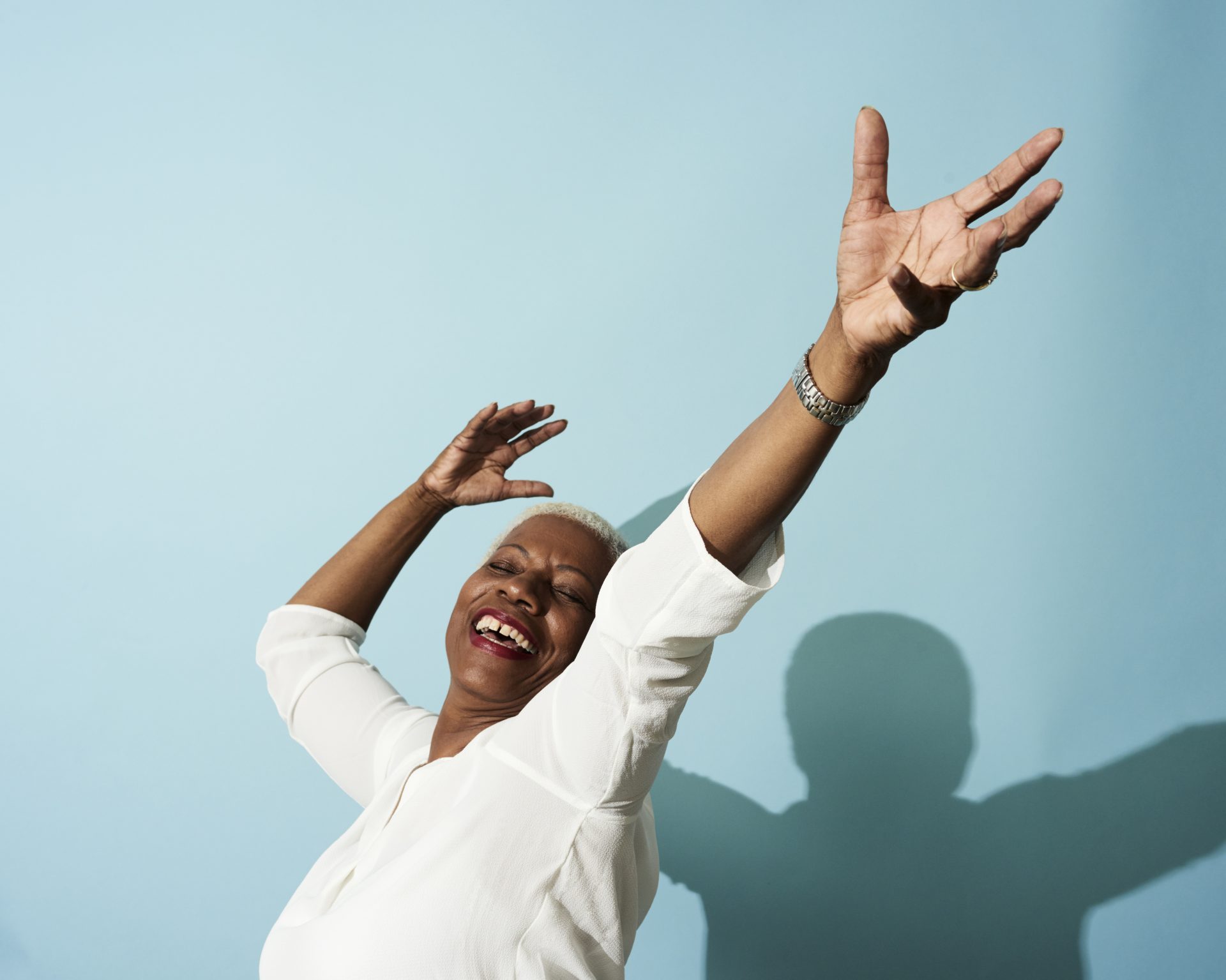In desperate need of a pick-me-up? Strong Women editor Miranda Larbi tried a science-backed ‘joy workout’, and found herself smiling in less than 10 minutes.
There’s nothing like a glum morning to make you feel grey – especially when the news is dire, it’s set to rain and you’ve got a ton of work to get through. Whatever the day, I always like to start proceedings with a workout but when it’s cold and dark outside, it takes a Herculean effort to schlep out of bed to do something vigorous (even if you know it’ll be worth it in the end).
To really get your head in the game, you want to get your heart racing and those endorphins pumping. And it was while scouting around for inspiration – cough, lying in bed – that I came across something that seemed way too good to be true: an 8.5 minute ‘joy’ workout.
The premise is simple: you follow six key moves (reaching, swaying, bouncing, shaking, jumping and something mysteriously named ‘celebrate’) and by the time you’ve finished, you should be feeling joyful.
You may also like
Health benefits of walking: why 20 minutes of walking is enough to boost immunity, heart health and happiness
Now, I’m all in favour of micro-movement. During lockdown, I used to do lots of 10-minute workouts on FIIT to break up the day and I totally believe that any movement is good movement. Just getting up from your desk to run up and down the stairs or go once around the block is enough to make you feel re-energised. But I’d argue that eight minutes isn’t long enough to get the endorphins going. As a runner, I know only too well that the golden runners’ high is hard won. It often only kicks in after about 20 minutes, and even then, the conditions need to be right.
Nevertheless, I thought I’d put this 8.5-minute joy workout to the test. And you know what? I was wrong.
What is the joy workout?
It’s an 8.5 minute workout that’s been devised by psychologist Kelly McGonigal. Writing in the New York Times, she explains that the workout is made up of six science-backed key moves:
- Reach
- Sway
- Bounce
- Shake
- Jump for joy
- Celebrate
The science behind the workout
Researchers have found there are certain stock movements in many cultures that signal joy. Those include:
- Swaying from side to side
- Reaching your arms up into the air
- Bouncing to the beat
- Taking up space
These movements don’t just show that we’re feeling joy, but they’ve also been found to bring about that feeling in the first place.
One study, published in Frontiers in Psychology, cites a previous piece of research which got people to either stay in an open/expansive posture, or a closed posture for two minutes. Scientists found that those who did the first move felt more powerful, had lower stress levels and tended to take more risks; while participants who did the closed pose had higher cortisol levels.
A small 2021 study looked at whether certain moves can make us happier. 25 people were asked to do a series of movements including jumping, free flowing, spreading, rising and moving to the rhythm.

The study found that happiness can be enhanced by doing these kinds of movements, with researchers concluding that their results “support the role of movement in changing or including an emotional state”. Interestingly, jumping was the main movement that people reported as having the biggest impact on their happiness – something backed up by previous studies that found that happiness was significantly enhanced by jumping.
That all kind of makes sense – lots of animals express confidence and feelings of safety and happiness through different movements. Look at a cat, for example. If a cat’s feeling content and secure, it might roll onto its back and let you stroke its belly. If it’s on edge, it’ll arch its back to protect vulnerable bits of its body like the stomach.
Does the joy workout work?
So, there I am, at 8am on a miserable morning, plugged into this workout. It starts slowly, getting me to reaching my arms to the sky before moving onto gentle bopping from side to side. Slowly, it becomes more dynamic with a little knee bend and a reach.
Before long, I’m swaying from side to side, kind of like I’m doing funky Tai chi. I move around, eyes closed, imagining that I’m in a salsa club – arms out. And then the bounce starts. I bounce my shoulders up and down, then heels, and suddenly, I’m skipping an imaginary rope. And that’s when I start smiling in spite of myself. McGonigal suggests throwing your fists in the air like a kid bouncing for joy – and I’m going for it.
Probably my favourite bit is the ‘shake’. You start by shaking one arm, then the next, then both. Shaking legs, shaking every part of the body. I’m well aware that I must look bonkers to anyone walking past my window but I’m shaking my arse, neck, shoulders – and feeling really relaxed. Which is good because the next section is about jumping for joy while looking up, punching the sky and bouncing.
The ‘celebrate’ part of the workout mimics throwing confetti into the air and that’s a surprisingly emotive move. I’m there chucking imaginary confetti at every direction – twisting and bouncing, expanding my arms and chest in a way that feels incredible and weirdly novel. In no regular workout do you ever stretch your arms out in such an expansive way (except perhaps when you’re coming into mountain pose from a forward fold in yoga).
The final element is freestyle. For these last few minutes, I close my eyes and just move in any way I can. I’m shaking, bouncing, bending, stretching.
You may also like
Why don’t I feel a runner’s high after jogging? Here’s why not everyone experiences a post-workout endorphin rush
At the end of the 8.5 minutes, I feel… great. Despite my reservations, I really do feel happy. Sure, this workout isn’t massively taxing and you’re not sweating by the end but it’s a brilliant pick-me-up and the kind of thing you could do in between meetings from home when you’re feeling overwhelmed by work, want to move but don’t want to get changed or log onto Zoom glistening with sweat.
One key element here is the music. The New York Times has chosen weird Sims-like music that fits with each move and I’m sure that’s important. One of the studies mentioned previously flags the fact that moving to the beat can have a big impact on mood, so you probably do need to choose a few tracks that fit to the movements you’re about to do – with tempos you can follow.
In any case, I’m now convinced that eight minutes of shaking and bouncing is enough to feel happier. And we could all do with a bit more happiness right now.
Images: Getty
Source: Read Full Article
